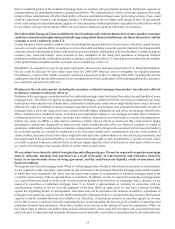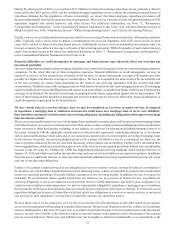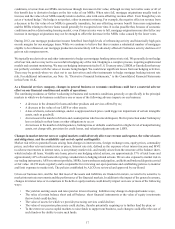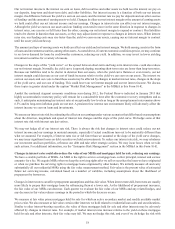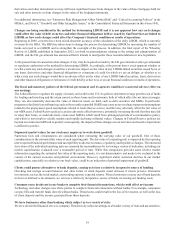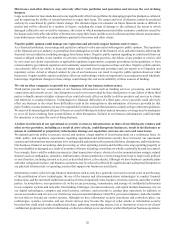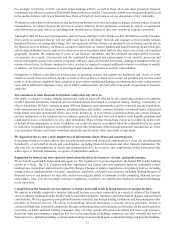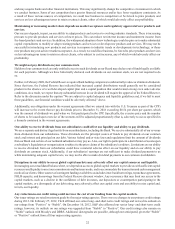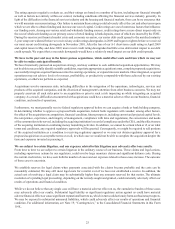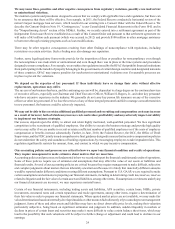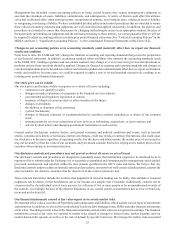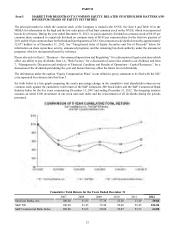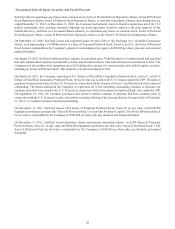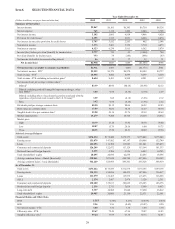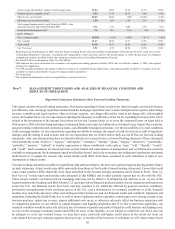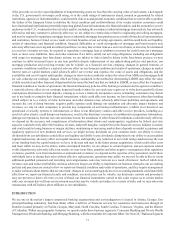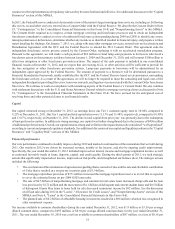SunTrust 2012 Annual Report Download - page 40
Download and view the complete annual report
Please find page 40 of the 2012 SunTrust annual report below. You can navigate through the pages in the report by either clicking on the pages listed below, or by using the keyword search tool below to find specific information within the annual report.24
We may incur fines, penalties and other negative consequences from regulatory violations, possibly even inadvertent
or unintentional violations.
We maintain systems and procedures designed to ensure that we comply with applicable laws and regulations, but there can
be no assurance that these will be effective. For example, in 2011, the Federal Reserve conducted a horizontal review of the
nation's largest mortgage loan servicers, which resulted in our entering into a Consent Order with the Federal Reserve. We
describe the Consent Order in Note 19, “Contingencies,” to our Consolidated Financial Statements in this Form 10-K and in
the "Nonperforming Assets" section of the MD&A. Further, we recently entered into a settlement agreement as part of the
Independent Foreclosure Review established as a result of this Consent Order and pursuant to that settlement agreement we
will make a $63 million cash payment (which was accrued in 2012) and provide $100 million in other mortgage assistance
to borrowers through existing programs such as loan modifications.
There may be other negative consequences resulting from other findings of noncompliance with regulations, including
restrictions on certain activities. Such a finding may also damage our reputation.
Further, some legal/regulatory frameworks provide for the imposition of fines or penalties for noncompliance even though
the noncompliance was inadvertent or unintentional and even though there was in place at the time systems and procedures
designed to ensure compliance. For example, we are subject to regulations issued by the OFAC that prohibit financial institutions
from participating in the transfer of property belonging to the governments of certain foreign countries and designated nationals
of those countries. OFAC may impose penalties for inadvertent or unintentional violations even if reasonable processes are
in place to prevent the violations.
We depend on the expertise of key personnel. If these individuals leave or change their roles without effective
replacements, operations may suffer.
The success of our business has been, and the continuing success will be, dependent to a large degree on the continued services
of executive officers, especially our Chairman and Chief Executive Officer, William H. Rogers, Jr., and other key personnel
who have extensive experience in the industry. We generally do not carry key person life insurance on any of the executive
officers or other key personnel. If we lose the services of any of these integral personnel and fail to manage a smooth transition
to new personnel, the business could be adversely impacted.
We may not be able to hire or retain additional qualified personnel and recruiting and compensation costs may increase
as a result of turnover, both of which may increase costs and reduce profitability and may adversely impact our ability
to implement our business strategies.
Our success depends upon the ability to attract and retain highly motivated, well-qualified personnel. We face significant
competition in the recruitment of qualified employees. Our ability to execute the business strategy and provide high quality
service may suffer if we are unable to recruit or retain a sufficient number of qualified employees or if the costs of employee
compensation or benefits increase substantially. Further, in June, 2010, the Federal Reserve, the OCC, the Office of Thrift
Supervision, and the FDIC jointly issued comprehensive final guidance designed to ensure that incentive compensation policies
do not undermine the safety and soundness of banking organizations by encouraging employees to take imprudent risks. This
regulation significantly restricts the amount, form, and context in which we pay incentive compensation.
Our accounting policies and processes are critical to how we report our financial condition and results of operations.
They require management to make estimates about matters that are uncertain.
Accounting policies and processes are fundamental to how we record and report the financial condition and results of operations.
Some of these policies require use of estimates and assumptions that may affect the value of our assets or liabilities and
financial results. Several of our accounting policies are critical because they require management to make difficult, subjective
and complex judgments about matters that are inherently uncertain and because it is likely that materially different amounts
would be reported under different conditions or using different assumptions. Pursuant to U.S. GAAP, we are required to make
certain assumptions and estimates in preparing our financial statements, including in determining credit loss reserves, reserves
related to litigation and the fair value of certain assets and liabilities, among other items. If assumptions or estimates underlying
our financial statements are incorrect, we may experience material losses.
Certain of our financial instruments, including trading assets and liabilities, AFS securities, certain loans, MSRs, private
investments, structured notes and certain repurchase and resale agreements, among other items, require a determination of
their fair value in order to prepare our financial statements. Where quoted market prices are not available, we may make fair
value determinations based on internally developed models or other means which ultimately rely to some degree on management
judgment. Some of these and other assets and liabilities may have no direct observable price levels, making their valuation
particularly subjective, being based on significant estimation and judgment. In addition, sudden illiquidity in markets or
declines in prices of certain loans and securities may make it more difficult to value certain balance sheet items, which may
lead to the possibility that such valuations will be subject to further change or adjustment and could lead to declines in our
earnings.


